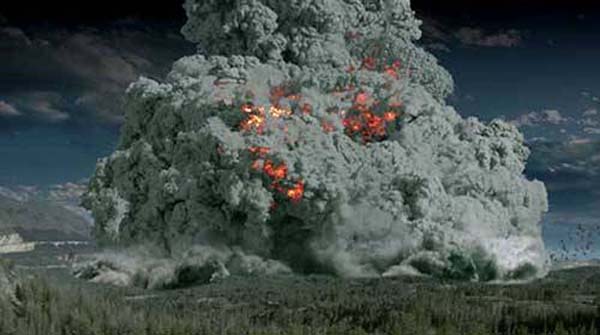
A supervolcano is a Volcano capable of producing a volcanic eruption with ejecta greater than 1,000 cubic kilometers (240 cubic miles). This is thousands of times larger than most historic volcanic eruptions.
Supervolcano is the popular term for a large volcano that usually has a large caldera and can potentially produce devastation on an enormous, sometimes continental, scale. Such eruptions would be able to cause severe cooling of global temperatures for many years afterwards because of the huge volumes of sulfur and ash erupted. They are the most dangerous type of volcano.
Supervolcanoes can occur when magma in the Earth rises into the crust from a hotspot but is unable to break through the crust. Pressure builds in a large and growing magma pool until the crust is unable to contain the pressure. This kind of eruption is typically sufficient to cause a long-lasting change to weather (such as the triggering of an ice age) sufficient to threaten the extinction of species, and cover huge areas with lava and ash.
Though there is no well-defined minimum explosive size for a supervolcano, there are at least two types of volcanic eruptions that have been identified as supervolcanoes: large igneous provinces and massive eruptions.

The Discovery Channel highlighted six known supervolcanoes: the Yellowstone, Long Valley, and Valles Caldera in the United States; Lake Toba, North Sumatra, Indonesia; Taupo Volcano, North Island, New Zealand; and Aira Caldera, Kagoshima Prefecture, Kyushu, Japan.
Supervolcanoes were seen on other planets via the Voyager program craft on the moons of Jupiter and Saturn. However, this kind of volcano on Earth was not discovered until long after the Voyager had gone on to their interstellar missions. The outer Solar System volcanoes were mostly cryovolcanoes, not magma volcanoes. Theoretically a supervolcano could be a cryovolcano, but none has been found within the solar system.
In the News ...
Yellowstone Has Bulged as Magma Pocket Swells National Geographic - January 19, 2011
- Yellowstone National Park's supervolcano just took a deep "breath," causing miles of ground to rise dramatically, scientists report. The simmering volcano has produced major eruptions three times in the past 2.1 million years. Yellowstone's caldera, which covers a 25- by 37-mile (40- by 60-kilometer) swath of Wyoming, is an ancient crater formed after the last big blast, some 640,000 years ago.
List of Volcanoes
VOLCANO INDEX